| View previous topic :: View next topic |
| Author |
Message |
KDF-TX

Joined: 22 Jan 2008
Posts: 79
Location: Texas



|
 Posted: Aug 18, 2008 18:12 Post subject: Re: Endomorph or Pseudomorph? - Continuation Posted: Aug 18, 2008 18:12 Post subject: Re: Endomorph or Pseudomorph? - Continuation |
|
|
Thanks Jordi.
The label read "Hematite var. Martite", but it is a pseudomorph, not a var.? So it's not like amethyst is a variety of quartz?
|
|
| Back to top |
|
 |
Pete Modreski
Site Admin

Joined: 30 Jul 2007
Posts: 710
Location: Denver, Colorado



|
 Posted: Aug 18, 2008 18:13 Post subject: Re: Endomorph or Pseudomorph? - Continuation Posted: Aug 18, 2008 18:13 Post subject: Re: Endomorph or Pseudomorph? - Continuation |
|
|
Reading John's past column and thinking about this some more, I went back and looked again at the wording in that 1992 article I quoted that was one of the few from Am. Min. or elsewhere that mentioned endomorphs:
"They [the alunite-jarosite minerals at Broken Hill] occur as massive aggregates, pseudomorphs or endomorphs after pyromorphite or mimetite and as drusy crusts, single crystals, or groups of attractive, well-formed crystals."
With all apologies to Birch et al. who wrote that paper, given that we are defining endomorph as "...a perimorph is a mineral that encloses another mineral. The enclosed mineral... is defined as an endomorph."
With that in mind, how does one interpret the lines above; "endomorph after pyromorphite or mimetite"? Beats me... it sounds like, the term has just not always been used very clearly. If something is inside, it isn't really "after" anything.
Pete
|
|
| Back to top |
|
 |
Jordi Fabre
Overall coordinator of the Forum

Joined: 07 Aug 2006
Posts: 5089
Location: Barcelona



|
 Posted: Aug 19, 2008 10:29 Post subject: Re: Endomorph or Pseudomorph? - Continuation Posted: Aug 19, 2008 10:29 Post subject: Re: Endomorph or Pseudomorph? - Continuation |
|
|
KDF-TX,
Martite is not a variety name as it is a pseudomorph of two mineral species (not varieties): Magnetite and Hematite, so Martite is just a name used for that particular kind of pseudomorph.
"Variety" is a term commonly applied to minerals with slight differences with their related mineral species, and as far as I know, is not used for pseudomorphs.
Hopefully it helps
Jordi
|
|
| Back to top |
|
 |
John S. White
Site Admin

Joined: 04 Sep 2006
Posts: 1298
Location: Stewartstown, Pennsylvania, USA



|
 Posted: Aug 20, 2008 04:41 Post subject: Re: Endomorph or Pseudomorph? - Continuation Posted: Aug 20, 2008 04:41 Post subject: Re: Endomorph or Pseudomorph? - Continuation |
|
|
I am not sure that I totally understand what Pete is trying to say, but it appears to me that there are at least two different possible types of true pseudomorphs. In one case only part of the original mineral has been replaced, as in goethite after pyrite. The iron in the pyrite was not removed, while the sulfur was replaced by oxygen and hydrogen. I can envision another type of pseudomorph in which all of the mineral was removed leaving a cavity shaped like a crystal of the original mineral. If this cavity was subsequently filled by an entirely different mineral having no components from the original crystal, it should still be considered a pseudomorph, in my opinion, because it satisfies the classic definition of a pseudomorph. As far as I know a true pseudomorph does not have to retain some of the chemistry of the original mineral.
_________________
John S. White
aka Rondinaire |
|
| Back to top |
|
 |
Pete Modreski
Site Admin

Joined: 30 Jul 2007
Posts: 710
Location: Denver, Colorado



|
 Posted: Aug 21, 2008 16:52 Post subject: Re: Endomorph or Pseudomorph? - Continuation Posted: Aug 21, 2008 16:52 Post subject: Re: Endomorph or Pseudomorph? - Continuation |
|
|
John, I agree with,
" I can envision another type of pseudomorph in which all of the mineral was removed leaving a cavity shaped like a crystal of the original mineral. If this cavity was subsequently filled by an entirely different mineral having no components from the original crystal, it should still be considered a pseudomorph, in my opinion, because it satisfies the classic definition of a pseudomorph. "
that this would be a pseudomorph, and if existing inside an outer, enclosing mineral, I presume this would be considered an example of an "endomorph". But all I meant when I wrote was, that if one had an original crystal, say mimetite, that became surrounded and enclosed by new mineral growth by a second mineral, say, jarosite, one might consider this to be a pseudomorph, and to further, be an example of an endomorph-perimorph pair; but I don't think one would describe the mimetite as "an endomorph AFTER anything", because it doesn't exhibit any crystal form but its own.
This business all starts to give me a headache when I try to analyze it too carefully. Can we just go back to referring to all as "pseudomorphs", and leave it at that?
cheers, Pete
|
|
| Back to top |
|
 |
Aymeric
Joined: 20 Feb 2009
Posts: 32
Location: Between France & Pakistan


|
 Posted: Feb 20, 2009 17:19 Post subject: Re: Endomorph or Pseudomorph? Posted: Feb 20, 2009 17:19 Post subject: Re: Endomorph or Pseudomorph? |
|
|
| Excellent reading, thank you very much Mark ! I'm regularly confronted to what I used to call pseudomorphs, and know I see them under a new light ! aaaaah, the pleasure of learning !
|
|
| Back to top |
|
 |
Pete Richards
Site Admin
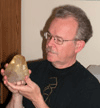
Joined: 29 Dec 2008
Posts: 846
Location: Northeast Ohio



|
 Posted: Feb 20, 2009 19:27 Post subject: Re: Endomorph or Pseudomorph? Posted: Feb 20, 2009 19:27 Post subject: Re: Endomorph or Pseudomorph? |
|
|
I agree with Mark that the use of pseudomorph as a general term is useful. I had never heard of endomorph before, and to my thinking it does not make any sense. If the original mineral is inside (endo) it has not morphed! I could see using the term endomorph for a cast as Mark defines it, but I think the number of situations where it could be applied unambiguously is pretty small. You would have to determine that an epimorph was cast with a new mineral and dissolved away leaving an "endomorph" in this sense, AND that this was the process instead of simple replacement pseudomorphy. Not likely.
Incidentally, the terms mold and cast are in common usage in paleontology. The mold is what is left when the fossil dissolves away and the matrix retains the shape, and a cast is what results when the hollow space is filled in with another mineral.
An interesting cross-discipline experiment: take a nice brachiopod fossil and immerse it in a concentrated solution of copper sulfate. After a week or so, you'll have a brachiopod made at least in part of malachite - a pseudomorph of malachite after brachiopod!
_________________
Collecting and studying crystals with interesting habits, twinning, and epitaxy |
|
| Back to top |
|
 |
Peter Megaw
Site Admin

Joined: 13 Jan 2007
Posts: 975
Location: Tucson, Arizona



|
 Posted: Jan 26, 2010 13:55 Post subject: Re: Endomorph or Pseudomorph? Posted: Jan 26, 2010 13:55 Post subject: Re: Endomorph or Pseudomorph? |
|
|
Here is a beautiful example of development of an epimorph/encrustation pseudomorph from the famous "crazy lace" agate locality in Chihuahua. We have an exploration project called "Cinco de Mayo" surrounding the locale...and it appears genetically related to the Au-Ag-Pb-Zn-Cu-Mo mineralization we're chasing, so we've had rare justification for paying close attention to it. I have always been fascinated by the patterns in crazy lace...sharp rectilinear banding mixed with wild arcuate banding...but frustrated by only having standard 30 x 40 oval cabochon samples to study.
In examining outcrops of the agate it became apparent that the agate filled voids in a limestone breccia developed along a complex thrust fault. The breccia clearly ruptured repeatedly and voids were alternately filled with fine-grained laminated sediments (cave fill) and scalenohedral calcite with silicification occurring repeatedly. The patterns of the "ghosts" of the scalenohedral calcites suggested fillings remarkably similar to the "diente de perro" (dog-tooth) calcite that cements limestone breccias at Santa Eulalia, which helped in understanding what is going on. It was easy to find hand-samples of silicified cave fill showing beautiful cross-bedding, the difficulty was to get a manageable size piece that showed the dog-teeth unequivocally. I finally succeeded recently in getting couple of slabs of just such a piece and am delighted with the results Here are three increasing close-up scans that show what happened and demonstrate how this epimorph developed.
It clearly looks like scalenohedral calcite was first coated with something...now silica, and then the body of the crystal dissolved away leaving "voids" above and below the "crust" into which beautifully banded chalcedony could grow In essence an "endomorph" that lost its "morph" leaving just a delicate "endo". (Being an ex-physical anthropologist ectomorph en route to becoming a mesomorph, I think this term should be abandoned in favor of epimorph...but I am not trying to stir the semantic pot here).
Note that the growth bands work both ways off the coating, suggesting that it was somehow supported...probably in silica gel. If you look very closely you can see that there were crystallites of something elongate...and silica tubules as well...that also grew in both directions off the crust. These appear to have had more 'elbow-room" to grow off the original free faces of the calcite however suggesting that things were more liquid in that direction. Notably the banding is not symmetrical with respect to the crust, perhaps indicating it remained a barrier to gel or fluid movement across the void. It also looks like the red iron-oxide coloring was introduced late along the "veinlet" that cuts across the banding.
Looking at more chaotic banding iin many crazy lace agates I suspect that in many cases the crust collapsed and formed piles of shards that then got overgrown by the agate stage...and cutting through these at various angles gives the wild patterns the material is famous for.
Happy to hear agate and pseudomorph experts weigh in on this!!!
| Description: |
| Crazy lace agate slab about 16 cm across |
|
| Viewed: |
43179 Time(s) |
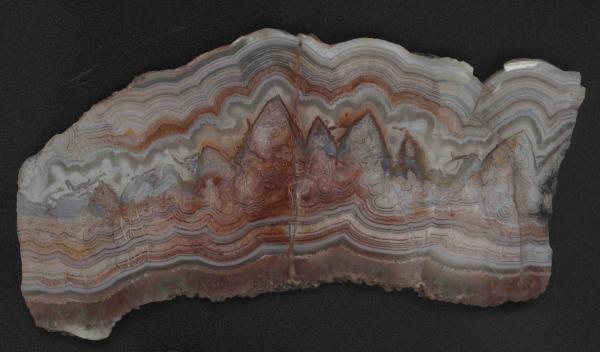
|
| Description: |
| Close-up view of crazy lace agate...field of view about 6 cm |
|
| Viewed: |
43162 Time(s) |
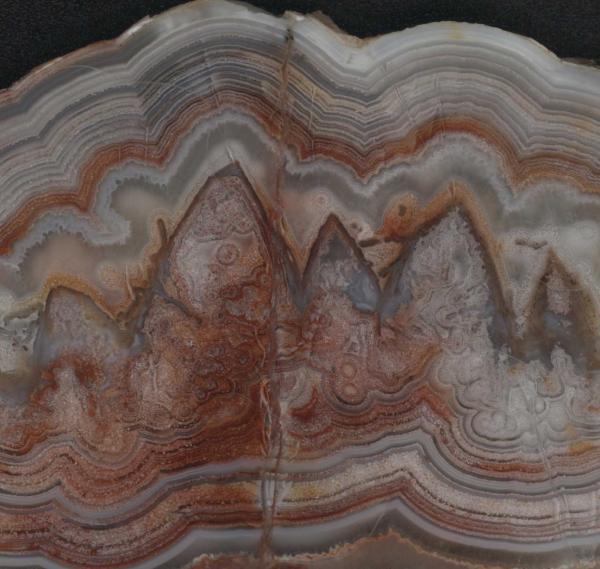
|
| Description: |
| Closest-up view of crazy lace agate...field of view about 4 cm |
|
| Viewed: |
43157 Time(s) |
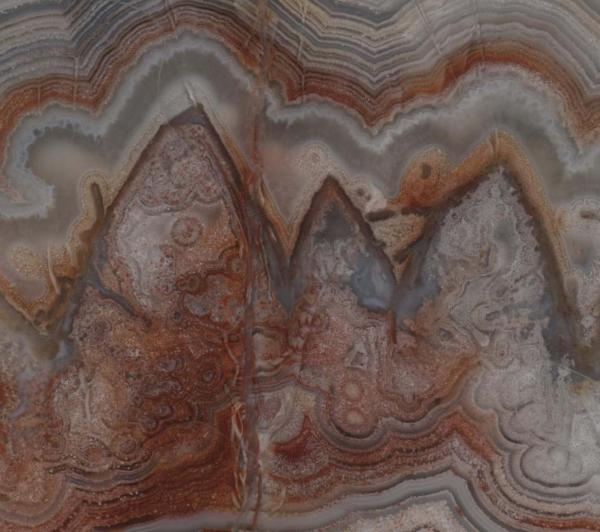
|
_________________
Siempre Adelante! |
|
| Back to top |
|
 |
Tomasz Praszkier
Joined: 20 Dec 2009
Posts: 93
Location: Warszawa



|
 Posted: Jan 26, 2010 14:46 Post subject: Re: Endomorph or Pseudomorph? Posted: Jan 26, 2010 14:46 Post subject: Re: Endomorph or Pseudomorph? |
|
|
Mark,
My English is poor but... Did I well understood that in your opinion perimorphose=epimorphose?? For this kind of coatings with dissoluted primary mineral I always used term perimorphose.
Tom
_________________
Tomek |
|
| Back to top |
|
 |
Pete Richards
Site Admin

Joined: 29 Dec 2008
Posts: 846
Location: Northeast Ohio



|
 Posted: Jan 26, 2010 18:18 Post subject: Re: Endomorph or Pseudomorph? Posted: Jan 26, 2010 18:18 Post subject: Re: Endomorph or Pseudomorph? |
|
|
Peter,
Certainly these are very interesting images. Could you please put the specimen through a tomograph and show us the slices perpendicular to this viewing direction? That would be very helpful in deciding whether the original mineral was calcite. But it might require a four-dimensional tomograph with retroactive capability, and not many labs have that....
Cheers
_________________
Collecting and studying crystals with interesting habits, twinning, and epitaxy |
|
| Back to top |
|
 |
Peter Megaw
Site Admin

Joined: 13 Jan 2007
Posts: 975
Location: Tucson, Arizona



|
 Posted: Jan 26, 2010 18:29 Post subject: Re: Endomorph or Pseudomorph? Posted: Jan 26, 2010 18:29 Post subject: Re: Endomorph or Pseudomorph? |
|
|
Pete, tongue-in-cheek aside, the surface outcrops of these do give a 3D view and they are symmetrical with respect to the axis of elongation...but I suspect you would only be convinced of calcite if I ran it through a dual-channel reframitizer with proactive processing and at the moment that senstive piece of equipment has burned out another filament...
_________________
Siempre Adelante! |
|
| Back to top |
|
 |
Antonio Da Silveira

Joined: 11 Oct 2007
Posts: 25
Location: Artigas


|
 Posted: Jan 26, 2010 18:59 Post subject: Re: Endomorph or Pseudomorph? Posted: Jan 26, 2010 18:59 Post subject: Re: Endomorph or Pseudomorph? |
|
|
Amethyst Pseudomorph, Artigas Uruguay.
Antonio
| Description: |
Amethyst Pseudomorph tall 28 cm
"Santiño Mine" |
|
| Viewed: |
43105 Time(s) |
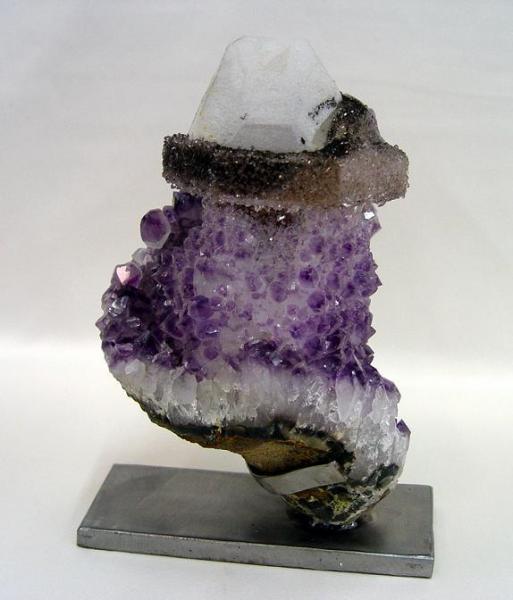
|
| Description: |
| Amethyst Santiño Mine, Uruguay |
|
| Viewed: |
43158 Time(s) |
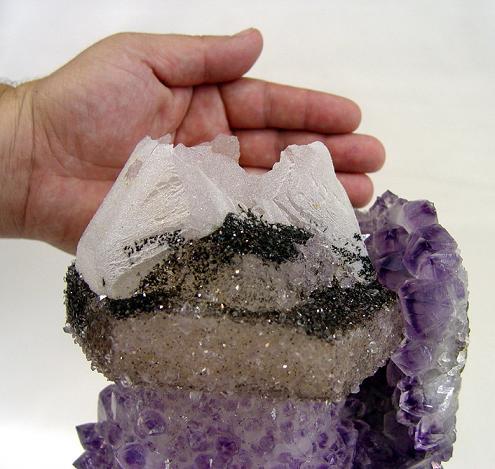
|
| Description: |
|
| Viewed: |
43106 Time(s) |
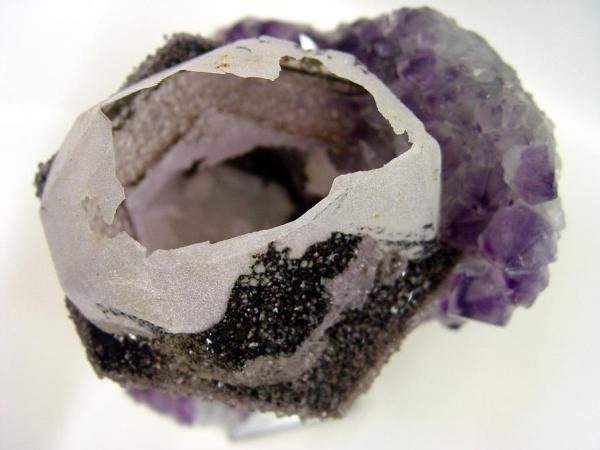
|
|
|
| Back to top |
|
 |
Jordi Fabre
Overall coordinator of the Forum

Joined: 07 Aug 2006
Posts: 5089
Location: Barcelona



|
|
| Back to top |
|
 |
John S. White
Site Admin

Joined: 04 Sep 2006
Posts: 1298
Location: Stewartstown, Pennsylvania, USA



|
 Posted: Jan 27, 2010 05:49 Post subject: Re: Endomorph or Pseudomorph? Posted: Jan 27, 2010 05:49 Post subject: Re: Endomorph or Pseudomorph? |
|
|
Antonio:
I have seen several very similar specimens recently from Artigas. They are magnificent and they defy understanding. Talk about multi-stage paragenesis, there must have been at least a half-dozen events in the development of this amazing specimen.
_________________
John S. White
aka Rondinaire |
|
| Back to top |
|
 |
John S. White
Site Admin

Joined: 04 Sep 2006
Posts: 1298
Location: Stewartstown, Pennsylvania, USA



|
 Posted: Jan 27, 2010 05:54 Post subject: Re: Endomorph or Pseudomorph? Posted: Jan 27, 2010 05:54 Post subject: Re: Endomorph or Pseudomorph? |
|
|
Peter, why are you still working with that obselete hardware? It is about time that you upgraded to newer technologies. (I really dislike technologies instead of technology, but it is very much in fashion these days and I use it here only because it seems to fit the sense of this thread.)
_________________
John S. White
aka Rondinaire |
|
| Back to top |
|
 |
|





